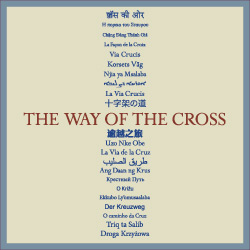The Way of the Cross
John F Sherman
This exhibition is a creative interpretation of the Way of the Cross set with the text of twenty-three languages and a minimal use of images. By using languages from all around the world, I hope to communicate that Christ came into this world to demonstrate a path to redemption by his ultimate sacrifice for all peoples of the world. My intention in this work is to show the journey Christ took to the cross is not only his journey, but my journey and the journey taken by everyone.
The Way of the Cross is a centuries-old Catholic liturgy usually held during the six weeks of Lent. Also known as the Stations of the Cross, each 'station' tells one chapter in the story of Jesus' road to Calvary. The fourteen stations are spaced throughout the interior of most Catholic churches and are often an integral component to the interior architecture by way of sculptural relief, mosaic, or painting. The Lenten liturgy of the Way of the Cross consists of prayers both sung and recited while a presider and/or group journey from station to station.
There have been several different versions of the Way of the Cross throughout the centuries. Most people are only familiar with the set used in recent centuries. In this body of work, however, I have chosen not to use these traditional fourteen stations, though many overlap. My design is based on a set of stations celebrated by Pope John Paul II on Good Friday in 1991. I did this for a variety of reasons, but mostly to help separate my designs from the traditional images found in many churches and most often come to mind. I also wanted a contemporary message for a modern universal church. We have personal images of Christ's passion as we meditate and pray from station to station. Since each station contains essentially text alone, the reflection that develops at each station is not based on an illustration but on a reflection based on what the words are saying to us. Since so many of the words are foreign to us, we cannot help but intertwine into our reflection the struggles and concerns of the people of Africa, Asia, Europe, and South America.

In many ways, the story of Calvary is also our story. On one side of Christ, one prisoner rejects hope and the opportunity for reconciliation with God. However, the prisoner on the other side is able to see that reconciliation and peace can be achieved even at this late hour. Christ is at the center and is the bridge between despair and hope, death and life. We too can strive to be a bridge for all peoples to find hope and peace in their lives.
A number of people helped in the translations for this project, for which I am very grateful. The languages are listed below in the order they are used at left.
Hindi
Greek
Vietnamese
French
Latin
Swedish
Swahili
Aramaic
Italian
Japanese
English
Chinese
Igbo (Nigeria)
Spanish
Arabic
Filipino
Russian
Slovene
Luganda (Uganda)
German
Portuguese
Maltese
Polish
Felicitas Font Design
The text of this Way of the Cross exhibition is set in an original font design named Felicitas. The font is available in Roman, Italic, Bold, Bold Italic, and the Roman font includes a number of Ornaments and Celtic Borders.
Felicitas is inspired by Eric Gill's design for Perpetua introduced in 1929 by the Monotype Type Foundry. My drawing is more organic than Gill's and features a number of innovative special characters and ligatures.
Felicitas also takes advantage of opentype technology which provides the font designer new design opportunities. More can be learned about Felicitas at :
Felicitas